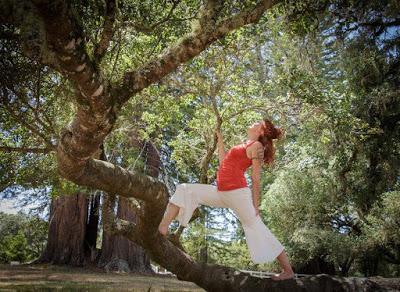
Yoga in a Tree by Melina Meza
After delving into strength and flexibility, (see Techniques for Strength Building with Yoga, and Techniques for Cultivating Flexibility), Nina and I are moving on to agility. This time, after our usual time spent on research, discussion, and debate, we’ve come up with a basic set of guidelines for how you can use your yoga practice for improving and maintaining agility. Remember that agility is balance in motion, so although you will get some help improving your agility via static poses—balancing poses or otherwise—it’s a good idea to introduce dynamic practices as well.An important thing to consider when you move into agility practices is how agile you already are, both in your everyday life in the type of yoga you are practicing. If you are pretty sedentary and have not done much yoga, start with beginner level classes and practices before trying more challenging agility practices. Work you way up to more complex movements gradually over time.How Often to Practice. Since we use agility in our everyday activities, you can do agility practices every day. However, if your agility practice is a single vinyasa, for example, Sun Salutations, you risk overuse injuries from doing the same movements over and over. So if you want to work on agility every day, vary your agility practice from day to day. For example, you could do Sun Salutations every other day and Moon Salutations the other days. Or, you could simply alternate agility practice days with static strength and balance practices on the odd days. Balance Your Practice. Be sure to practice a wide variety of poses rather than just doing the same 10 every day. And when you’ve been practicing for a few years, you might even want to invent some new variations to keep things fresh and challenging. For example, you a create a practice out of several mini vinyasas, for example, starting with Cat/Cow pose, followed by Cobra pose/Child’s pose, dynamic Downward-Facing Dog pose, two rounds of mini Sun Salutations, dynamic Warrior 2 pose, and so on. Or you could make up your own vinyasa by linking different poses together in a flow sequence.If you just love doing Sun Salutations, try varying the flow a bit to challenge and test your agility. For example, instead of stepping your foot straight back from Standing Forward Bend (Uttanansa), step it back and to the outside edge of your mat, and then step your second foot back to the opposite side of the mat, for a wider stance in Downward-Facing Dog pose (Adho Mukha Svanasana). Making little changes like that help keep your practice fresh and stimulating for you agility. Dynamic Poses. When practicing these pose, be clear about what your starting and full pose positions are. Then choose an appropriate focus for the particular pose or practice. For example, for dynamic Warrior 2 pose, you could bring attention to the bend of your front leg, aiming it straight ahead and stopping at 90 degrees. Or, if you were doing dynamic Bridge pose, you could focus on keeping your breath smooth and coordinating the movements of your hips and arms with it. When you start to practice, move with precision between the two positions, coordinating movement with breath, maintaining your chosen focus. How Fast to Move. Although the research is not yet definitive, it may turn out that varying your speed strengthens different muscle fibers. It’s likely that faster movements use fast-twitch muscle fibers, which assist in building stronger, more explosive muscles as well as improving agility, while slower movements use slow-twitch muscle fibers, which lead to more endurance. So when you’re practicing dynamic poses or flow sequences, it’s a good idea to vary your speed. Some days you might work at a slower pace through your entire agility practice, while on other days you work at a faster clip. You can also do this within a given session, doing a set of dynamic repetitions slowly first, and repeating it again at a faster pace. Static Poses. Although not as effective for promoting agility as dynamic poses, you can use your static poses to cultivate agility by moving in and out of the pose with care and precision. While you are in the pose, practice mindfully to improve your proprioception (see below).Floor Poses. Do them! Do them every day! Get down to and up from the floor to do seated and reclined poses, even if you need to use a chair or the wall to help you up and down. Look for opportunities to do this in your everyday life, too.Improve Proprioception. Focus on improving proprioception in all your poses to enhance agility. In static poses, take some time to really feel your own alignment. Are you arms even in Warrior 2? Are you knees actually straight in your standing poses? Is your head really aligned directly over your torso? In dynamic poses, you can pick either a single movement to focus on or focus on keeping your breath smooth as you coordinate breath and movement.To take your proprioception to another level, work with more subtle alignment cues. For example, you could work with your shoulder blades, your collarbones, your inner thighs, or something even more esoteric like your psoas muscles. Sometimes there is an area you are not used to even sensing and, at first, it will be hard to feel something there. But the more you bring your mind to it, the easier it will be to sense that area and eventually to move it.Taking vision out of the equation helps improve proprioception as you’ll need to work with your sense of where your body is in a space to compensate for lack of sight. That’s how you can walk in the dark! So you can experiment by practicing in a darkened room or keeping your eyes closed.
Subscribe to Yoga for Healthy Aging by Email ° Follow Yoga for Healthy Aging on Facebook ° Join this site with Google Friend Connect

